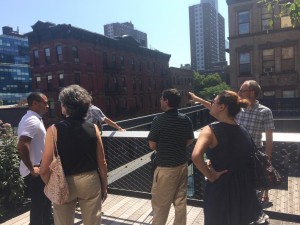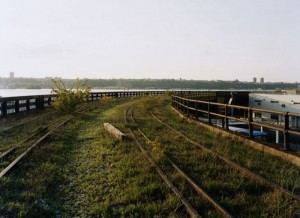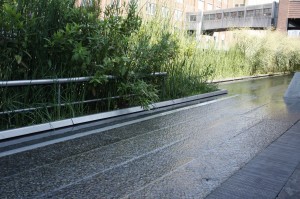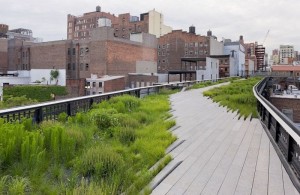From Behind the Mounds: Walking the Line

The Freshkills Park development team on a tour of the High Line
During a clear and comfortable late July morning, the staff of Freshkills Park was given a behind-the-scenes tour of one of Manhattan’s most popular destinations: The High Line. With Vice President of Park Operations Martin Nembhard and Director of Horticulture Tom Smarr as our guides, we were treated with a glimpse into their new office building as well as a detailed accounting of their landscape design and management strategies. At roughly three stories above street level and with a worked landscape that would make any naturalistic gardener or plant lover swoon, it is easy to see why this fairly recent park is such a success.
Beginning at the southern end of the High Line, Martin shepherded us through the newly-finished Diller-von Furstenberg Building which serves as the hub of operations and management for The Friends of The High Line, the privately-funded caretakers of the elevated city park. At 20,000 square feet and with LEED Silver status, the High Line office provides desperately needed space for landscape set-up, operations, and outreach efforts headed up by the organization. The Diller-von Furstenberg Building easily blends into the park landscape, allowing staff members to get plant materials and equipment out onto the grounds without interrupting or being visually displeasing to park visitors.

Image courtesy of NYC Parks, the City of New York
After we finished ‘oohing and aahing’ at what the office building had to offer, we were led out onto the High Line by Tom to gain some insight into their planted landscape. Weaving through park visitors (the park is especially a hit with tourists), Tom described the state of the elevated freight line after it had been abandoned and interest began growing in turning this piece of Manhattan’s history into a park. Filled with plant life, mostly opportunistic – some may say weedy – herbaceous and woody perennials, this found-landscape inspired James Corner Field Operations landscape architecture firm (the same firm that designed the Master Plan for Freshkills Park) to incorporate this theme into the final design that visitors see today. From Winged Sumacs that look eerily similar to Tree of Heaven to the Pincushion Plant which evokes an image of fields full of clover, many of the plants represent those that were found on the abandoned tracks more than a decade ago.
Beyond making these important interim plants a theme of the landscape, several different plant ecosystems were evident as we strolled north. Passing through woodlands, grasslands, a wetland, a thicket, and even past a well-trimmed lawn, it was apparent that a great deal of thought was given into representing the diverse and varied ecosystems that can be found within New York City. At one point, Tom and Martin gave us privileged access to their composting operation where they turn their plant clippings into organic and nutrient-rich fertilizer. Viewing their horticultural operations from this vantage point, it was easy to see the benefits of sustainable gardening and landscape maintenance.

Image courtesy of Ian K. Cooke (September 2012)
While the current park is a remarkable place, it hasn’t finished growing or changing. Tom explained to us that the third and final section of the High Line has entered the final phase of construction. Set to open in the fall, this section will wrap around the new development going up at the Hudson Yards between 30th and 34th Streets. The plant landscape in this section will again embrace the wild and naturalistic feeling that early High Line advocates discovered in the late 1990s. In addition to this final segment opening, the success of the High Line initiating redevelopment of the western edge of Chelsea is likely setting the stage for a slow change in the plant regime. Sections experiencing the construction of high-rise residential buildings may see that certain plants that are thriving in their current conditions will no longer be a good fit for those spaces. The High Line’s plan is not to fight this, but to allow for a change in the landscape to occur. Just as plant ecosystems change in the wild due to shifting conditions, this process will be reflected in the managed landscape so many people have come to enjoy.

Image courtesy of NYC Parks, the City of New York
It was truly an enlightening and unique opportunity to discover the history, the operational endeavors, and the ecological insights that a city park has embraced, helping it to become a destination. This sharing experience between the High Line and Freshkills Park will continue when High Line staff get their own behind-the-scenes tour of Freshkills and learn of our unique landscapes and ecosystems. Both parks are reclamations from modern human impacts and both can learn immensely from each other.





